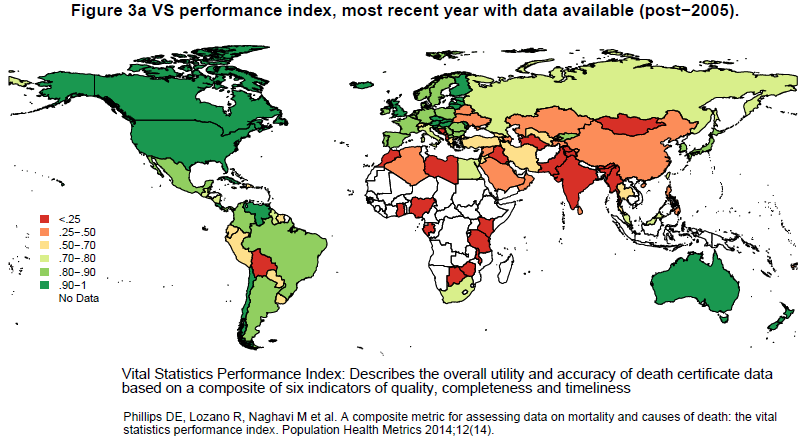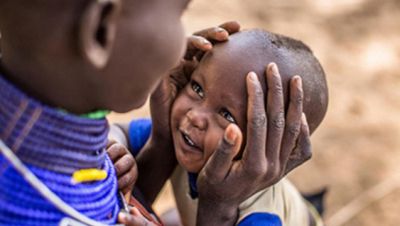In developed societies we take it for granted that all children are registered at birth and that all people are registered when they die with a medically assigned cause of death. We hardly think about birth and death registration because we rarely are the initiators; it is usually the institution where the birth takes place that registers the baby, and the undertaker who registers a death. Our involvement is typically limited to choosing a name for the child and signing the registration papers.
In most developing countries, however, the onus is entirely on the family to register a birth or death. Even assuming they are aware of this obligation, it often requires substantial effort and expense and can take several weeks. This in part explains why so many births and deaths go unrecorded.
Why do we need a birth certificate? Certainly, the issuance of a birth certificate is consistent with the Convention on the Rights of the Child that states that every child should be registered immediately after birth. And in almost all societies a birth certificate is a basic legal document that gives identity to a child, and automatically bestows a number of rights such as the right to health care, nationality, schooling, passport, property ownership, voting, formal employment, or access to banking services. While, for the family of the deceased, a death certificate ensures their right to inherit property, to access business and financial entitlements, and to claim any available insurance benefits.
But registration is also vital for national planning. The civil registration records of births and deaths are necessary for countries to compile accurate, complete and timely vital statistics, which, along with population censuses, are central to estimating population size – especially for small areas. Without knowing the size and composition of the local population, how can local authorities decide how much – and what type of essential services to provide? Similarly, the cause of death data from civil registration systems are vital for pinpointing the diseases and injuries that are cutting lives short and for planning preventive services to avoid premature mortality. Cause of death data are also useful to inform governments about outbreaks of fatal disease. Consider the recent Ebola outbreak. Once the outbreak was spotted it was important to look back in time to see which recent deaths might have been from the disease but not diagnosed, not least to trace those who had contact with the victim. This requires a solid system of registration, without such data policymakers lack reliable evidence to design policies: they are “flying blind”. And when governments fly blind then they are often making policy on the basis of ideology, anecdotes or for political considerations, rather than on evidence.
Unfortunately there remain huge gaps in the availability and quality of these crucial data in many parts of the world. And this presents a major challenge to evidence-based public policy. How bad is the problem? Well, you can judge for yourself from the accompanying map which ranks the world’s mortality registration systems according to their quality in six different categories. Very few low and middle-income countries have functioning cause of death information systems that they can draw on to guide policies for health and human development.

Only about 65% of all births are registered globally and only about one third of the world’s 55 million annual deaths are recorded through civil registration1, and up to 80 percent of deaths that occur outside of health facilities are not counted.
UNICEF for example estimates that only 44 per cent of births among sub-Saharan Africa’s children under-five years of age are registered today, and in rural areas, it is even lower. Birth registration varies widely, from 3 per cent in Somalia to 95 per cent in South Africa2. Globally, only one in four people lives in a country that registers over 90% of births and deaths.
The systematic neglect of civil registration and vital statistics has been identified as “the single most critical failure of development over the past 30 years”3.It has become increasingly clear that without reliable vital statistics we cannot monitor progress towards our development goals nor national development policies. As the international community seeks to define a new development agenda post 2015, the awareness of the need to strengthen civil registration in many countries has spread and funds have finally begun to flow from the donor community: both from philanthropic organisations and the international development agencies4, 5.
With increased funding comes a need to monitor progress in improving – or even setting up systems for civil registration and vital statistics (CRVS). A composite indicator has recently been developed to do just this: the “vital statistics performance index”6. What is equally important though is to measure how the lives of those - mostly poor people, who are born, live and die uncounted, improve as a result of being registered. Perhaps it is time to give international prominence to an indicator of the ability of a country to register all its births and deaths. If human development is about giving people more freedom and opportunities in life, then a birth registration certificate is fundamental to a person’s right to an identity and the entitlements that go with it, be they education, participation in community life, employment or freedom from exploitation. All of which improve and enrich people’s lives.
To speed up progress with civil registration a new way of doing business is required. Many registration systems are still paper based. But widespread mobile phone ownership (and cell coverage) in many of the poorest countries has considerable potential. Information technology can improve how authorities access, collect and store birth and death registration data, and cause of death information. Indeed, birth registration is already benefitting from new technologies: in Albania, Kosovo, Pakistan and other countries, ‘geo-mapping’ technologies have facilitated the collection and visualization of birth registration data.
Cooperation between different donors will be essential if we are quickly to address the vast inequalities in CRVS development and so provide policymakers with the evidence to tackle premature death and reduce suffering. Improved vital statistics are also necessary to track the impact of the more than $30 billion they spent annually in international cooperation on health in developing countries7.
We very much welcome the recent international momentum to register all births and deaths and to monitor causes of death nationally and subnationally, by the only sensible means possible - better quality and more complete civil registration data.
Lene Mikkelsen heads LM-Consulting and holds an honorary appointment at the University of Melbourne
Alan Lopez is a Laureate professor of global health at the University of Melbourne.
David E. Phillips is a researcher at the Institute for Health Metrics and Evaluation at the University of Washington in Seattle.
Notes:
- Mikkelsen L., Phillips D E, Abouzahr C. et al. (2015) A global assessment of civil registration and vital statistics systems: monitoring data quality and progress. The Lancet D-14-00220 S0140-6736(15)60171-(In press)
- United Nations Children’s Fund, Every Child’s Birth Right: Inequities and trends in birth registration, UNICEF, New York, 2013 http://www.unicef.org/esaro/5480_birth_registration.html
- Setel P, Macfarlane SB, Szreter S, Mikkelsen L.,Prabhat J, Stout S and Abouzhar C (2007). A scandal of invisibility: making everyone count by counting everyone. Lancet, 370(9598):1569–1577. doi:10.1016/S0140-6736(07)61307-5. Available at: http://www.who.int/healthinfo/statistics/WhoCounts1.pdf
- World Bank Group (2014) Global Civil Registration ad Vital Statistics. Scaling up Investment Plan 2015-2024. Available at
http://www-wds.worldbank.org/external/default/WDSContentServer/WDSP/IB/2014/05/28/000456286_20140528170841/Rendered/PDF/883510WP0CRVS000Box385194B00PUBLIC0.pdf - http://www.bloomberg.org/press/releases/bloomberg-philanthropies-launches-100-million-data-health-program-developing-countries/
- Philips DE, Lozano R, Naghavi M et al. (2014). A composite metric for assessing data on mortality and causes of death: the Vital Statistics Performance Index. Population Health Metrics,12:14 . Available at: http://www.pophealthmetrics.com/content/12/1/14/abstract
- Murray CJL (2015) The Data for health initiative: Improving availability and quality of health data. Available at:
http://www.healthdata.org/acting-data/data-health-initiative-improving-availability-and-quality-health-data?utm_source=IHME+Updates&utm_campaign=ce7cdc4cad-Weekly_Email_July_22_20147_14_2014&utm_medium=email&utm_term=0_1790fa6746-ce7cdc4cad-418799421
Photo credit: Juhan Sonin (Flickr)
The HDialogue blog is a platform for debate and discussion. Posts reflect the views of respective authors in their individual capacities and not the views of UNDP/HDRO.


